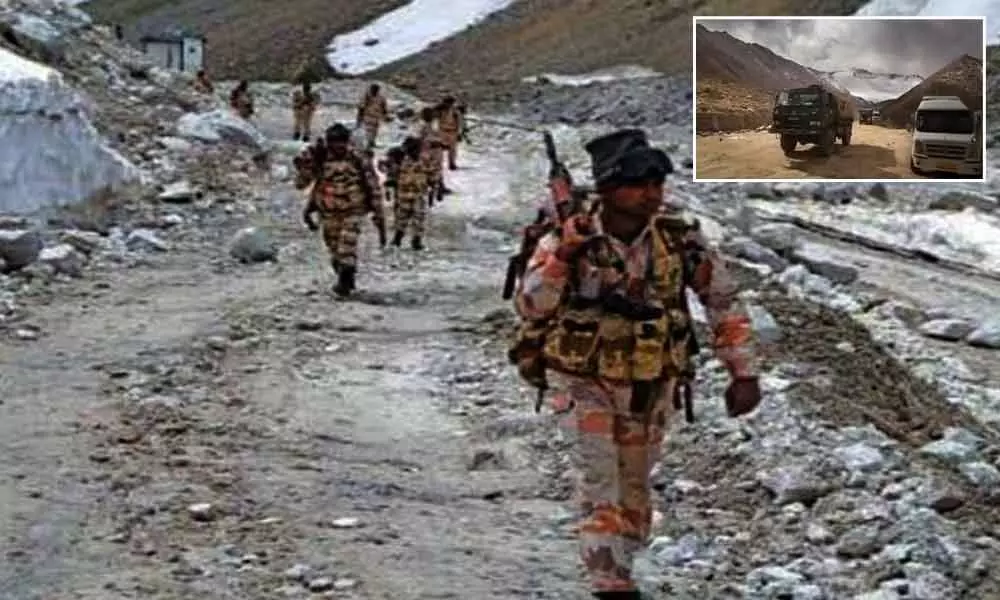Live
- Take police 'highhandedness' on CT Ravi seriously: K'taka Governor to Siddaramaiah
- Redmi 14C 5G Launched in India: Budget Smartphone Under Rs 10,000
- Football: Indonesia appoints Dutch legend Patrick Kluivert as head coach
- Amazon Launches Alexa-Enabled Echo Spot in India: Features, Price and More
- CM Mohan Majhi invites Indian diaspora to join developmental journey of Odisha
- United Breweries Halts Kingfisher Beer Supply to Telangana
- Human Metapneumovirus (HMPV): Understanding the infection and its impact on cancer patients
- Businessman Boby Chemmanur Arrested After Sexual Harassment Claims
- Akali Dal protests move to re-designate Advisor’s post to Chief Secy in Chandigarh
- Tax Breaks Galore: No Tax on Income Up to Rs. 7.75 Lakhs in the New System
Just In
India, China bring in heavy equipment and weaponry to their rear bases near eastern Ladakh


Indian and Chinese armies were moving in heavy equipment and weaponry including artillery guns and combat vehicles to their rear bases close to the disputed areas in eastern Ladakh as the two militaries remained engaged in a bitter standoff along the troubled border for over 25 days, military sources said.
Indian and Chinese armies were moving in heavy equipment and weaponry including artillery guns and combat vehicles to their rear bases close to the disputed areas in eastern Ladakh as the two militaries remained engaged in a bitter standoff along the troubled border for over 25 days, military sources said on Sunday.
The enhancement of combat capability by the two armies in the region came even as both the countries continued their efforts to resolve the dispute through talks at military and diplomatic levels.
The Chinese Army has been gradually ramping up its strategic reserves in its rear bases near the Line of Actual Control in eastern Ladakh by rushing in artillery guns, infantry combat vehicles and heavy military equipment, the sources said.
The Indian Army has also been moving in additional troops as well equipment and weapons like artillery guns to aggressively match up to the Chinese build-up, they said, adding that India will not relent till status quo is restored in Pangong Tso, Galwan Valley and a number of other areas.
The Indian Air Force has been keeping a strict aerial surveillance in the disputed region.
A sizeable number of Chinese Army personnel entered into the Indian side of the de-facto border earlier this month and have been camping in Pangong Tso and Galwan Valley since then. The Indian Army fiercely objected to the transgressions by the Chinese troops and demanded their immediate withdrawal for restoration of peace and tranquility in the area.
The Chinese Army has ramped up their presence in Demchok and Daulat Beg Oldie too -- the two sensitive areas with a history of skirmishes involving the two sides.
The Chinese army is learnt to have deployed around 2,500 troops in Pangong Tso and Galwan Valley besides gradually enhancing temporary infrastructure and weaponry. However, there is no official figure about the numbers.
Sources said satellite images have captured significant ramping up of defence infrastructure by China on its side of the de-facto border including construction activities at a military airbase around 180 kms from the Pangong Tso area.
The assessment by the Indian Army is that the build-up is aimed at putting pressure on India.
"We are well aware of the Chinese ploy. The Indian Army is firm on its stand that we are not going to accept anything less than restoration of status quo in the area," said a senior military official.
Defence Minister Rajnath Singh on Saturday said bilateral talks were on at military and diplomatic levels with China to resolve the row.
The trigger for the face-off was China's stiff opposition to India laying a key road in the Finger area around the Pangong Tso Lake besides construction of another road connecting the Darbuk-Shayok-Daulat Beg Oldie road in Galwan Valley.
The sources said China was also laying a road in the Finger area which is not acceptable to India.
The sources said military reinforcements including troops, vehicles and artillery guns were sent to eastern Ladakh by the Indian Army to shore up its presence in the areas where Chinese soldiers were resorting to aggressive posturing.
The situation in eastern Ladakh deteriorated after around 250 Chinese and Indian soldiers were engaged in a violent face-off on the evening of May 5 which spilled over to the next day before the two sides agreed to "disengage".
However, the standoff continued.
The incident in Pangong Tso was followed by a similar incident in North Sikkim on May 9.
The troops of India and China were engaged in a 73-day stand-off in Doklam tri-junction in 2017 which even triggered fears of a war between the two nuclear-armed neighbours.
The India-China border dispute covers the 3,488-km-long LAC. China claims Arunachal Pradesh as part of southern Tibet while India contests it.
Both sides have been asserting that pending the final resolution of the boundary issue, it is necessary to maintain peace and tranquility in the border areas.

© 2024 Hyderabad Media House Limited/The Hans India. All rights reserved. Powered by hocalwire.com






